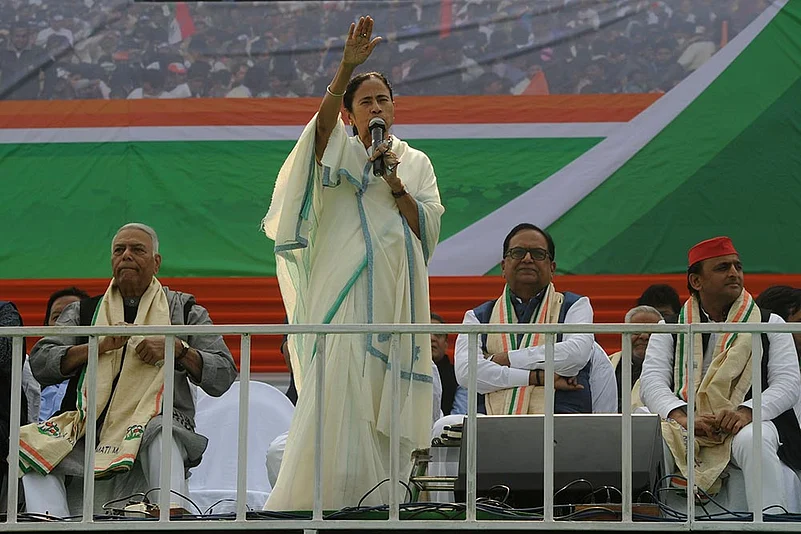Winter haze hung over the iconic Brigade parade ground in the heart of Calcutta. A cutout of Trinamool Congress (TMC) supremo and Bengal chief minister Mamata Banerjee towered over a sea of supporters. And the bold letters in Bengali on the cutout proclaimed the collective wish of a bevy of political leaders gathered for the ground-breaking event: “Chalo paltai, ebar amra Dilli chai (Let’s bring in change, we want Delhi this time).”
On January 19, Mamata achieved what many thought was impossible till a few weeks ago—barring Odhisha chief minister Naveen Patnaik’s Biju Janata Dal (BJD), she brought together virtually every major opposition party on one platform to launch what could be one of the biggest political conglomerations in India in recent times. The major takeaway from the gathering was that the TMC boss managed to cobble together a cohesive and viable alternative to the BJP with a single agenda to oust the Narendra Modi-Amit Shah duo. It was a rare show of unity among a group of parties which would otherwise be bickering; the common refrain was about burying political and ideological differences and together taking on the Modi-Shah duopoly. Speaker after speaker highlighted the “pain” caused to the common people by demonetisation and Goods and Services Tax (GST). They spoke about the Modi government’s poor record in job creation and a growing agrarian distress. And they made references to the Rafale deal, peppering their speeches with questions on Modi’s integrity.
But the event was as much the story of Mamata’s own personal ambitions as it was about the Opposition’s show of unity. For years now, the maverick politician has not made any attempt to hide her prime ministerial ambitions. At the rally too, she played the role of emcee with a professional and personal touch, receiving each of the guests, walking them to the dais and introducing them before inviting them to address the gathering. She was the master of ceremonies, the show-stealer. With Bengal firmly in her grasp, her followers have all the more reasons to see the general elections as the last leg of her journey to “Dilli”. Bengal has 42 Lok Sabha seats and how many her party manages to win will determine her bargaining powers, in case the coalition manages to overthrow the BJP-led NDA. At present, Trinamool has 34 MPs and is expecting to win at least 40. This could leave Mamata with the largest group of lawmakers barring the Congress. If it manages to get to or improve its 2014 tally of 44, that is.
Over the past few weeks, the number of leaders endorsing the 63-year-old former Congress leader as the potential prime minister too has gone up, including Karnataka chief minister H.D. Kumaraswamy and BJP leader Shatrughan Sinha. What went unnoticed in the rally is the presence of Pu Lalduhawma of the Zoram Nationalist Party (ZNP) of Mizoram, who also gave the thumps up to Mamata as the PM. It’s rare for a party from the Northeast to approve a regional leader to lead the country, much less a leader from Bengal.
Major challenges still remain for Mamata. For one, she may not be acceptable to all as the PM. DMK’s M.K. Stalin had famously named Congress president Rahul Gandhi as the Opposition’s potential choice. The Brigade parade ground rally also skipped the issue as Samajwadi Party’s Akhilesh Yadav insisted that the matter be left for after the elections. Most importantly, the Congress is unlikely to give up PM hopes, not after spectacular comebacks in three major states recently. And the fact that the Congress will be taking on the Trinamool in Bengal, apart from the BJP, makes it murkier.
Also, political coalitions are always a messy affair. Especially with ideologically diverse parties. Mamata may have brought the Opposition together, keeping the flock united would be the bigger challenge. The alliance still could be the Opposition’s answer to the BJP’s election winning machine. Or it could fall apart under the weight of its own contradictions. But the bullet has been fired and Mamata will be remembered as the one who pulled the trigger.
***
















